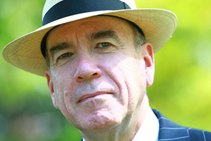Congressmen DeFazio and Oberstar are on campus
September 9th, 2010I had the opportunity yesterday to see the University of Oregon for what it is, in the eyes of those serving as architects of our community and our nation. The university not only is the largest player in the local construction trade – with current projects including the Matthew Knight Arena, the Ford Alumni Center, the East University Residence Hall and the Lewis Integrative Science Building – but we also lead the way in local and statewide planning and innovation.
In a meeting at the UO’s new John E. Jaqua Academic Center for Student Athletes, we hosted U.S. Reps. Peter DeFazio of Oregon and Jim Oberstar of Minnesota, along with dignitaries from Eugene, Springfield, Lane County and the Lane Transit District. Rep. Oberstar serves as chairman of the House Transportation Committee, while Rep. DeFazio is chairman of the Surface Transportation Subcommittee – and may have gotten his start as a leader in transportation policy while earning his master’s degree at the UO and working his way through school as a bike mechanic.
Wednesday’s initial topic of discussion was LTD’s bus rapid transit network, and exciting possibilities for a “multiway boulevard” as the transit district’s EmX line passes the UO on Franklin Boulevard. The concept, which originated in ancient Rome, would offer space to pedestrians, bicyclists, mass transit and automobiles in a landscaped corridor running through the campus of a great university.
That discussion touched on the dramatic facelift that our construction boom is bringing to the UO’s new “front door” on Franklin Boulevard and to the roles of Congress, local governments and the university in creating an infrastructure that blends our institution with the community. It led us on a side trip to the Interstate 5/Willamette River bridge construction site, to a broader view of interactions between the cities of Eugene and Springfield, and eventually to an impromptu briefing for the two congressmen on the UO’s remarkable Sustainable Cities Initiative.
UO professors Marc Schlossberg and Nico Larco, the initiative’s co-directors, told Reps. DeFazio and Oberstar about the program’s focus last year on the city of Gresham, where nearly 100,000 hours of student work from 21 courses and five academic departments was applied to projects throughout that city. And to the selection of Salem as the Sustainable Cities partner for the upcoming academic year, and the work to be done by more than 600 students and 25 faculty members from 25 UO courses.
That program is emblematic of what the University of Oregon is – and how we should be viewed – in our community, state and across the nation. We are a partner in creating and developing the future. We are a vital part of something grand.
